A striking representative of the new cocktail type - the tomato "Easter Egg": a full review
Cocktail varieties of tomatoes are rapidly gaining aficionados among discerning gourmets and experienced gardeners. The first like the appearance and taste of the fruit, the second - the process of cultivation. A juicy ripe tomato during the harvest period becomes the main prize, a source of pride and a measure of agricultural skill.
Among cocktail varieties, the Easter Egg lives up to its festive name. Its fruits have a regular ovoid shape with a bright red-yellow color. In the photo, they resemble works of art, as if it were not a creation of nature, but the famous Easter egg from Carl Faberge.
The content of the article
Description of the variety
Cocktail varieties are distinguished from other varieties primarily by their appearance.... They represent a new direction in tomato breeding, which came to Russia from Europe.
The name reveals the purpose of the vegetable - to decorate the table at buffets and cocktail parties. Cocktail cherry tomatoes are well known to most of our compatriots. In pickled form, these tomatoes have already become a favorite snack.
By the way... The Easter egg variety was created by breeders for open ground, but in the conditions of central Russia and the Moscow region, it is recommended to grow it in a greenhouse.
Distinctive features
The Easter egg variety is not as popular as cherry, but due to its merits it has every chance of becoming a favorite in the cocktail line.
Firstly, because of its decorative properties, its fruits are bright and attractive.
Secondly, the variety has undeniable consumer advantages - a specific aroma and sweet taste with a slight acidity, high density and keeping quality. And thirdly, this variety is quite suitable for cultivation even by novice gardeners.
Features of the variety:
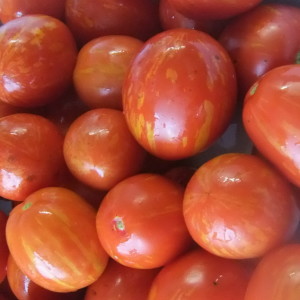
- indeterminate, a plant in height can reach 1.6-1.8 m, which leads to a high yield per unit area;
- equally good for growing both in the greenhouse and in the open field;
- begins to bear fruit early, 110 days after planting;
- resistant to disease and immune to many viruses, including the tobacco mosaic virus;
- unpretentious in care compared to other varieties of tomatoes.
Fruit characteristics and yield
The fruits of the Easter Egg variety cannot be confused with others - they are egg-shaped and red with yellow stripes.
Tomatoes ripen in clusters of 5-7 pieces, the weight of each varies between 60-90 g. On average, 5-7 kg of fruits can be harvested from a bush per season.
How to grow seedlings
Since the Easter Egg is a cultivar and not a hybrid, its seeds are sold unprocessed. You will have to independently provide your crops with protection from rot and mold.
Seeds are sown 45-60 days before transplanting plants to a permanent place in the beds, where they will grow for another 1.5-2 months. Calculate the terms in advance, taking into account the climatic features of a particular area.
Seed preparation
The seeds are soaked for 20 minutes in a 1% solution of potassium permanganate, then washed and immersed in any growth stimulator.It can be aloe juice diluted with water 1 to 1, a solution of honey (1 teaspoon per glass of warm water) or special formulations: "Epin", "Humat", "Energen".
reference... "Epin" is one of the most effective seed growth stimulants. Since it is a concentrate, use with extreme care. For germination, dilute 3 drops of the drug in 100 ml of water. In the future, it is also used for spraying seedlings. Concentration: 6 drops in 0.5 l of water.
Seeds are sown without waiting for them to peck, after keeping in a growth stimulator for 12 hours to a day. Plants treated in this way sprout amicably, do not suffer from blackleg and are resistant to stretching.
Capacity and soil
Shallow trays are prepared for seedlings. Fill them with purchased or self-prepared substrate. It is quite simple to prepare it: add one part of sod land and compost and half part of sand to 2 parts of peat.
It is recommended to add one glass of wood ash and a complex fertilizer of phosphorus, potassium and nitrogen to a bucket of such a mixture. Such soil contains all the macro- and microelements necessary for the normal development of plants.
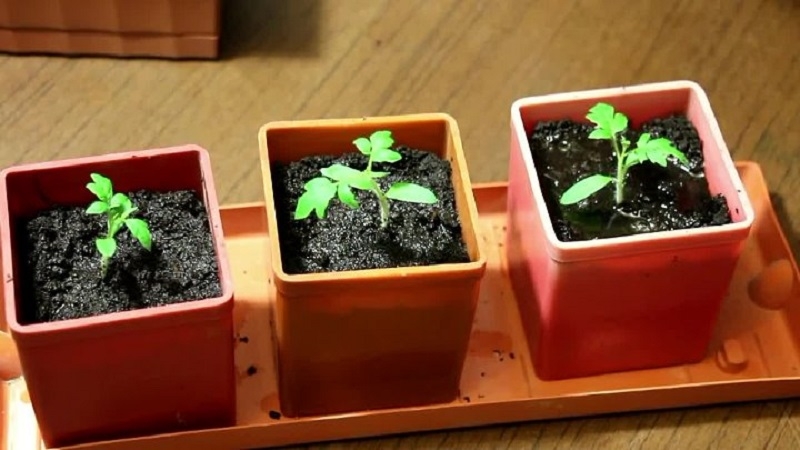
Important! Ready-made growing substrate can also be purchased in a specialized store. It is usually packaged in paper bags labeled "for tomatoes and peppers."
Sowing
The sowing depth should not exceed 1.5 cm, and the width between the grooves should not be less than 3 cm. The seeds are sprinkled with earth and watered abundantly, then covered with foil. In the future, they must be ventilated at least once a day. The optimum temperature for germination is 22–25 ° C.
Growing and care
The film is removed after emergence. The boxes are moved to a well-lit place. When 2-3 leaves are formed in the sprouts, it's time to start diving. As carefully as possible, so as not to damage the barely formed root system, seedlings with small pieces of soil are moved into individual containers. Peat pots are ideal for this.
The transfer of planting material to a permanent place is carried out after hardening the plants for 1 week. The seedlings are taken out into the open air, gradually increasing the time from 20 minutes to 2 hours a day.
How to grow an Easter egg
The cultivation technique of the variety is the same as that of other varieties and hybrids of indeterminate tomatoes. Tall bushes throughout the growing season will need special care.
Important! For favorable growth, trellises are required - supports for tying bushes. Each bush also needs timely leveling and pinching.
Landing
Transplanting to a permanent place is the next crucial moment. Time - one and a half to two months before the expected start of the harvest. Depending on the geographic location and climatic features of the area, the landing dates vary within the second half of May - early June.
Depending on the specific conditions, as well as on the experience of the farmer and his readiness for the vicissitudes of the weather, a place is also chosen: in a greenhouse or in an open field. Areas of little use for planting, where potatoes, peppers, tomatoes and other nightshades were cultivated in previous seasons. After these crops, the soil is significantly depleted in terms of the necessary macro- and microelements.
Light types of soil with preliminary drainage are more suitable for planting. It is advisable to decontaminate the soil by treating it with 1% potassium permanganate solution. Planting is carried out in depressions the size of peat pots in pre-formed beds, which are 80 cm wide and 30 cm high.
Important! It is recommended to add complex organic fertilizers to the holes. For example, the already mentioned "Humat", which, in addition to stimulating seed growth, has proven itself well as a top dressing for transplanting seedlings into the ground and subsequent care of the seedlings.
Plants are placed in parallel or staggered - this does not really matter. Simultaneously with the landing, the installation of supports or structures of trellises for tying bushes is carried out. Doing this later is not recommended in order not to damage the roots.
Care
Seedlings should be watered moderately with settled warm water, weeded and regularly loosened the topsoil around them to prevent root rot.
If you spend mulching - lay a layer of dried grass, straw or black non-woven fiber around each plant - the number of watering and loosening can be reduced. In this case, the layer of mulch should be at least 5 cm thick.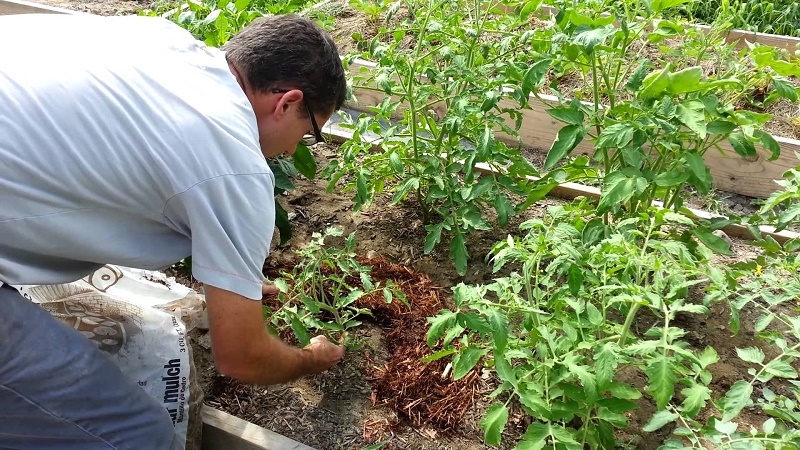
More attention and labor will require pinching and the formation of bushes. Timely removal of leaves and excess shoots-stepchildren allows the plant to mobilize all the resources of nutrients for the ovary and fruit growth. Therefore, the bush is usually formed into only two stems.
As the plant thus formed is pulled out, its stems are tied to supports and trellises. Garter, like pinching with pruning, is carried out throughout the vegetative period. They also regularly feed with complex mineral fertilizers.
Attention! Even with the correct preparation of the plot for tomatoes, with the preliminary introduction of organic fertilizers into the soil, normal growth will only be ensured by periodic fertilizing with mineral fertilizers. The soil needs a whole range of minerals: calcium, boron, magnesium, manganese, zinc, sulfur and others. But the most important components are 3 minerals: nitrogen, phosphorus and potassium.
It is necessary to select fertilizers in such a way as to make up for the lack of certain mineral elements - one, two or several at once. The lack of this or that element can be judged by the appearance of the plants.

Here are the specific signs of a deficit:
- nitrogen - yellowed leaves, elongated stems, the trunk becomes soft, and the veins on the underside of the leaf acquire a bluish tint;
- phosphorus - the stem becomes tough and brittle, and the leaves curl inward, the color of the plant changes to purple;
- potassium - the leaves darken, curl up into a tube, brown spots appear at the edges, forming a border.
Make up top dressing you can independently or purchase ready-made in the form of a complex fertilizer. Energen, which is not produced on the basis of coal, has proven itself well, which is why it is quite rightly referred to as fertilizers of natural origin. It contains trace elements based on sulfur and potassium salts of humic acids. It has an excellent effect on the active growth of plants throughout the growing season, increases productivity and increases the time of fruiting.
Important! When applying complex fertilizers, strictly adhere to the dosages and recommendations indicated on the package.
Features of cultivation and possible difficulties
There are no special cultivation features of the Easter Egg variety, different from other indeterminate tomatoes. This process will not cause difficulties even for novice amateur gardeners.
The main thing is to strictly adhere to a well-developed scheme, observing the sequence and timing of all manipulations with plants:
- From the moment of sowing the seeds to the transfer of seedlings to the ground, at least 60 days must pass.
- It is necessary to make pinching and shaping the bush on time.
- Depending on the condition of the plants, periodically feed them.
Caution! During the flowering period, fertilizing with nitrogen-containing fertilizers cannot be applied.
Diseases and pests
The variety is resistant to most tomato diseases. This circumstance is noted by almost all gardeners who cultivated the Easter egg. Even to the eternal misfortune of all nightshades - the tobacco mosaic virus. The variety also successfully resists many pests.
Due to excess moisture at low temperatures, blackening of the fruit is possible. Emergence late blight can be prevented by allocating a well-ventilated and sunny place for planting. Use a fungicide if necessary.
reference... Among the variety of fungicidal preparations, one can single out "Oxyhom", which perfectly protects tomatoes from late blight. It is a powdery fungicide for plant spraying. Before use, it is diluted in water in the proportion: 20 g per 10 liters of water.
The nuances of growing in open ground and in a greenhouse
This variety of tomatoes was bred for cultivation in the open field. This is how it is cultivated in the southern regions of Russia with a relatively mild and, most importantly, predictable climate. The nuances here boil down to providing a supply of warm, settled water for irrigation, as well as effective drainage of the beds in case of prolonged or heavy rains. Of course, you should also take care of the reliability of the supports so that they can withstand gusty winds and erosion.
In the regions located to the north, it is advisable to grow the Easter egg under plastic. Even in the Moscow region or Central Russia, it is worth protecting these generally unpretentious tomatoes from hail, hurricane winds and other vagaries of nature.
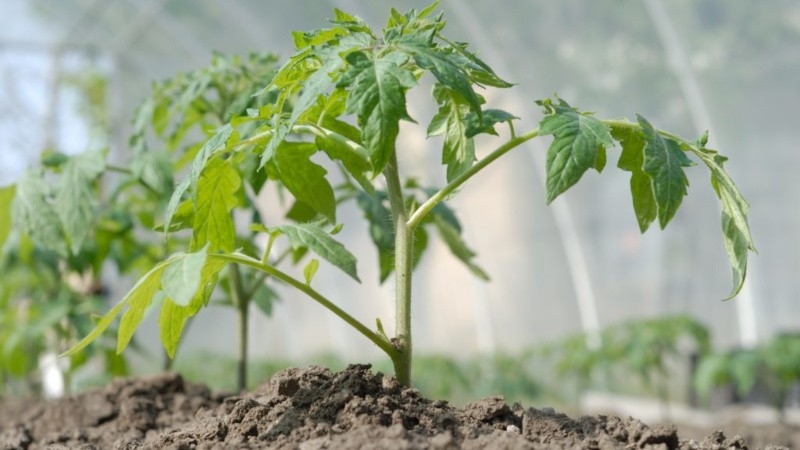
Wherein you need to carefully monitor the temperature and humidity level in greenhouses... Waterlogging of the soil must not be allowed. Ventilate and loosen the soil periodically. Another caveat: in the greenhouse, you should not abuse mulching in order to avoid mold and decay.
Harvesting and application of the crop
The Easter egg usually begins to bear fruit in late July.... Ripening with 5-7 brushes continues until the first frost. Thus, for about a month, fresh tomatoes can be served directly from the garden on the table set for a buffet table or cocktail. The excellent taste of these festively bright tomatoes is noted by almost everyone who had a chance to taste them: dense, fleshy, sweet with a slight sourness and a specific tomato aroma. Many people note that by the end of the season, the fruits become smaller and sweeter.
Interesting... The Easter egg can with good reason be called a universal variety due to its compactness, decorativeness and keeping quality.
Small tomatoes are suitable for whole fruit canning. The dense skin is resistant to cracking and mechanical damage, so the fruits tolerate transportation and long-term storage in a cool and dry place. But in terms of the production of juice or pasta, the Easter egg is inferior to large-fruited varieties of tomatoes.
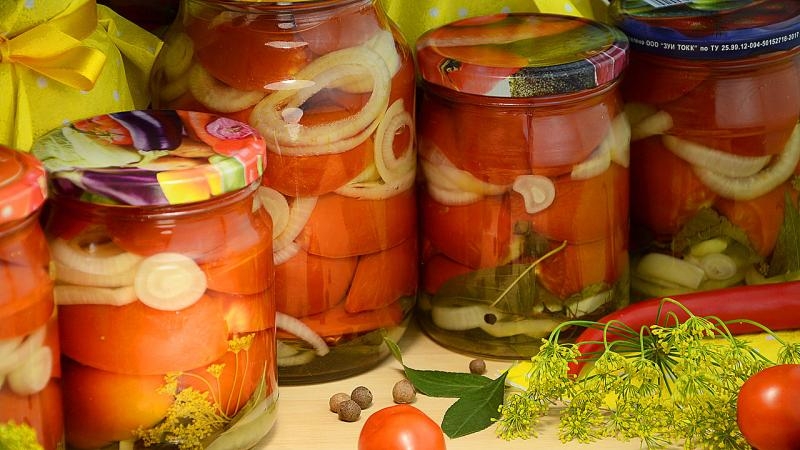
Advantages and disadvantages of the variety
The benefits of the Easter egg cocktail tomato variety include: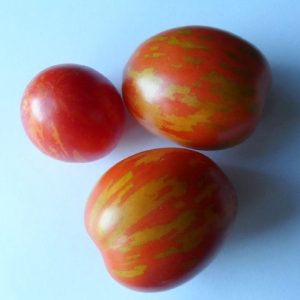
- excellent taste and attractive appearance;
- short ripening period;
- long fruiting period;
- high productivity;
- resistance to diseases and pests;
- versatility - suitable for fresh use and for conservation.
The variety is relatively laborious during the growing season when grown in soil. Requires regular strapping, pinning and trimming. Perhaps this is its only drawback.
Farmers reviews
Natalya Ivanovna, Moscow region: “I grew an Easter egg only once - last year. Of the positive qualities - high keeping quality and the possibility of transportation. I needed them, because I sell tomatoes. The variety interested my clients. They were satisfied with the taste. In general, for private business - one of the best options. "
Alexander Sidorov, Balashikha: “I grew the Easter eggs variety from seeds, planted seedlings in a greenhouse. I note the high productivity of the bush, beautiful fragrant fruits. Tomatoes are small, the pulp is juicy, raspberry-colored and unusually sweet in taste. I used it fresh and rolled it up. "
Nina Samoilova, Krasnodar: “A friend suggested the Easter eggs. Growing tomato bushes in the garden without a special shelter.The plant was very strong, the extra branches had to be removed. The fruits are amazingly colored: yellow stripes on a red background. The pulp is juicy, delicate in taste. The harvest made me happy. "
Conclusion
In conclusion, we can state: The Easter egg is, albeit a new, but very promising variety of tomatoes, a true achievement of breeders. He is relatively unpretentious in care. It can be grown both in the greenhouse and in the open field.
The variety is versatile in terms of using the harvested crop. An Easter egg is worth trying in your garden, and then taste and color!